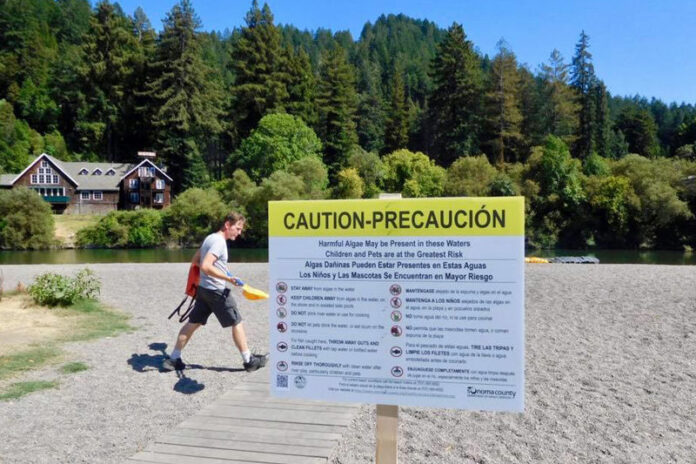Low levels of blue-green algae toxins have been reported present in the Russian River, according to the Sonoma County Department of Health Services.
On Wednesday, July 26, DHS received test results indicating that the level of toxins is high enough to trigger public warning.
“We have been watching conditions like the water temperature and visually monitoring the river,” stated Dr. Karen Milman, Sonoma County health officer. “When we noted conditions were present that could support rapid growth of algae, including blue-green algae, we started laboratory testing.”
DHS began testing the river weekly last Monday. After Wednesday’s elevated results, the county posted “caution” signs along Russian River beaches in English and Spanish.
Test results indicate there could be a risk to pets and children in particular and therefore “Caution” signs are being posted.
“Caution” is the lowest of three levels of state recommended advisory signage (“Caution” ”Warning” and “Danger”). A couple weeks ago, the Monte Rio Beach was closed for several days when tests indicated presence of E. coli bacteria.
Although, the Russian River is open for recreational use, the public should be advised that potentially harmful algae might be present, according to DHS. Care should be taken to keep children and pets away from algae, and prevent them from drinking river water.
“We want to inform people using the Russian River to take steps to protect themselves, their families and especially their pets,” Milman said. “Dogs like to eat things and are known to preferentially seek out blue-green algae. Be aware of this in deciding how you supervise your dog.
Signs will include these recommendations:
- Stay away from algae in the water.
- Keep children away from algae in the water, on the shore and in isolated side pools.
- Do not drink river water or use for cooking.
- Do not let pets drink the water, or eat scum on the shoreline.
- For fish caught here, throw away guts and clean fillets with tap water or bottled water before cooking.
- Rinse off thoroughly with clean water after river play, particularly children and pets.
Weekly laboratory testing will continue until two successive weeks of negative test results. River conditions will be monitored until they no longer support the rapid growth of blue-green algae.
Public Contact Information:
If you have concerns regarding your or your family’s health, contact your healthcare provider. If you have concerns regarding your pet’s health, contact your veterinarian. Be sure to tell the medical professional about possible contact with blue-green algae.
For questions regarding the status of the Russian River go to the website listed below or call the recorded beach hotline at (707) 565-6552.
• DHS Blue-Green Algae Website: http://www.sonoma-county.org/health/services/bluegreen.asp
The following websites provide more information on blue-green algae and harmful algal blooms:
• California Cyanobacteria and Harmful Algal Bloom (CCHAB) Network: http://www.mywaterquality.ca.gov/monitoring_council/cyanohab_network/index.html
• State Water Resources Control Board: http://www.waterboards.ca.gov/water_issues/programs/bluegreen_algae/
• Centers for Disease Control and Prevention (CDC): http://www.cdc.gov/habs/index.html









